Marketing Report: Aldi's Strategies, Mix, and Plan Analysis
VerifiedAdded on 2023/01/13
|12
|3255
|74
Report
AI Summary
This report provides a comprehensive analysis of Aldi's marketing strategies, focusing on its marketing mix, including product, price, place, promotion, people, process, and physical evidence. It compares Aldi's approach to that of Sainsbury's, highlighting key differences in their marketing mix strategies. The report also includes a detailed marketing plan for Aldi, encompassing an executive summary, situation analysis using SWOT analysis, and clearly defined objectives. The plan proposes the launch of in-house manufactured organic snacks, outlining strategies for market segmentation, positioning, and monitoring techniques. The report explores Aldi's strengths, weaknesses, opportunities, and threats, providing insights into its competitive positioning and strategic direction within the grocery retail market. The document is contributed by a student to be published on the website Desklib, a platform which provides all the necessary AI based study tools for students.
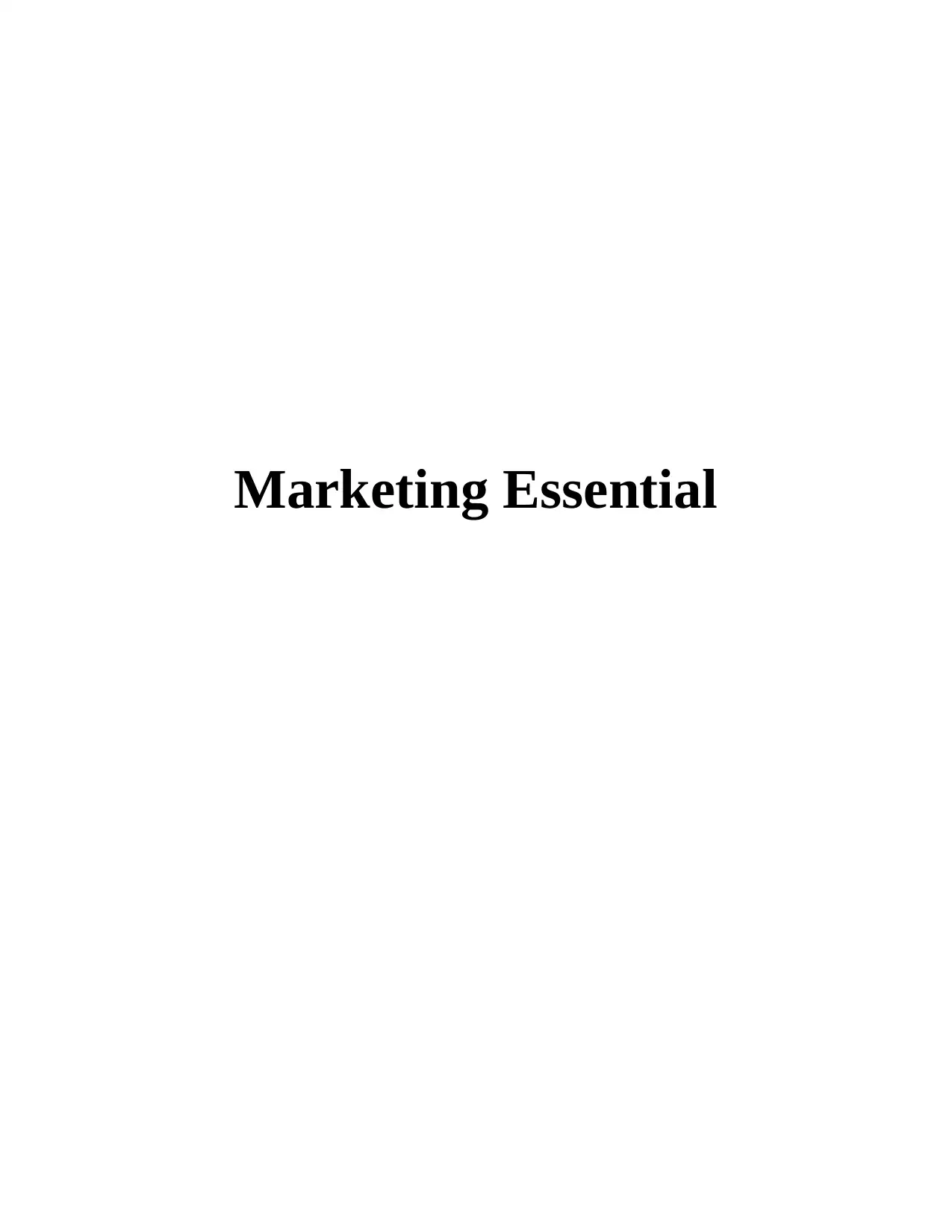
Marketing Essential
Paraphrase This Document
Need a fresh take? Get an instant paraphrase of this document with our AI Paraphraser
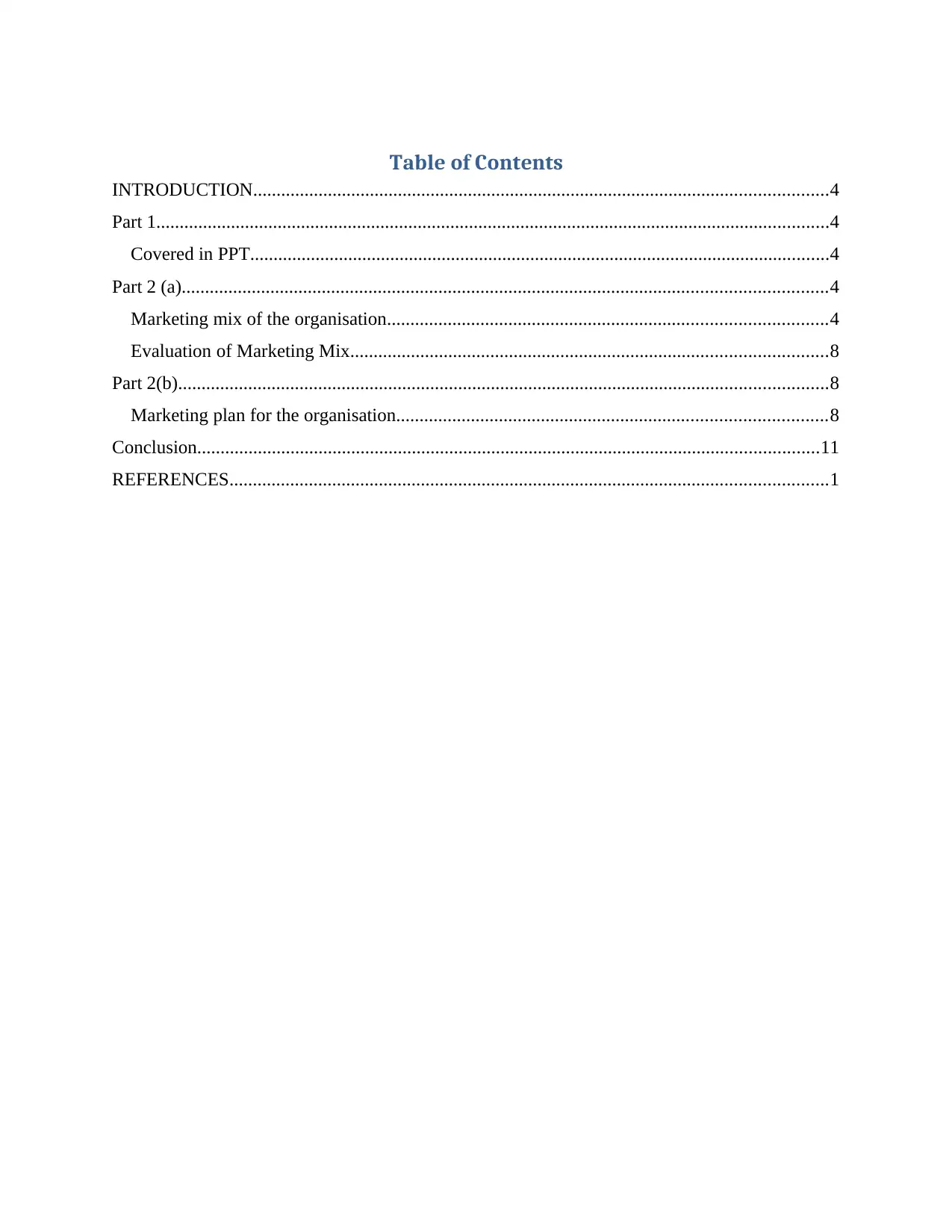
Table of Contents
INTRODUCTION...........................................................................................................................4
Part 1................................................................................................................................................4
Covered in PPT............................................................................................................................4
Part 2 (a)..........................................................................................................................................4
Marketing mix of the organisation..............................................................................................4
Evaluation of Marketing Mix......................................................................................................8
Part 2(b)...........................................................................................................................................8
Marketing plan for the organisation............................................................................................8
Conclusion.....................................................................................................................................11
REFERENCES................................................................................................................................1
INTRODUCTION...........................................................................................................................4
Part 1................................................................................................................................................4
Covered in PPT............................................................................................................................4
Part 2 (a)..........................................................................................................................................4
Marketing mix of the organisation..............................................................................................4
Evaluation of Marketing Mix......................................................................................................8
Part 2(b)...........................................................................................................................................8
Marketing plan for the organisation............................................................................................8
Conclusion.....................................................................................................................................11
REFERENCES................................................................................................................................1

⊘ This is a preview!⊘
Do you want full access?
Subscribe today to unlock all pages.

Trusted by 1+ million students worldwide
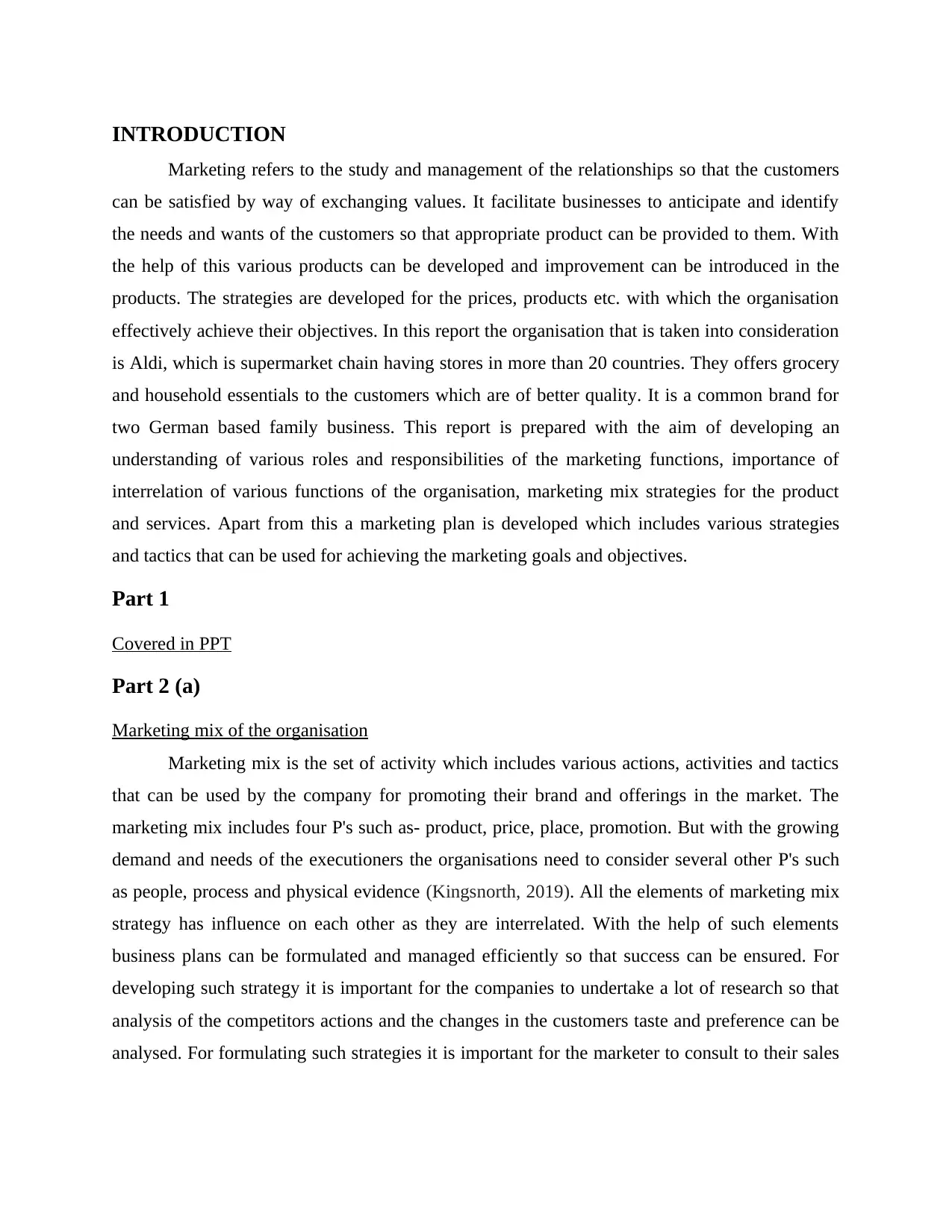
INTRODUCTION
Marketing refers to the study and management of the relationships so that the customers
can be satisfied by way of exchanging values. It facilitate businesses to anticipate and identify
the needs and wants of the customers so that appropriate product can be provided to them. With
the help of this various products can be developed and improvement can be introduced in the
products. The strategies are developed for the prices, products etc. with which the organisation
effectively achieve their objectives. In this report the organisation that is taken into consideration
is Aldi, which is supermarket chain having stores in more than 20 countries. They offers grocery
and household essentials to the customers which are of better quality. It is a common brand for
two German based family business. This report is prepared with the aim of developing an
understanding of various roles and responsibilities of the marketing functions, importance of
interrelation of various functions of the organisation, marketing mix strategies for the product
and services. Apart from this a marketing plan is developed which includes various strategies
and tactics that can be used for achieving the marketing goals and objectives.
Part 1
Covered in PPT
Part 2 (a)
Marketing mix of the organisation
Marketing mix is the set of activity which includes various actions, activities and tactics
that can be used by the company for promoting their brand and offerings in the market. The
marketing mix includes four P's such as- product, price, place, promotion. But with the growing
demand and needs of the executioners the organisations need to consider several other P's such
as people, process and physical evidence (Kingsnorth, 2019). All the elements of marketing mix
strategy has influence on each other as they are interrelated. With the help of such elements
business plans can be formulated and managed efficiently so that success can be ensured. For
developing such strategy it is important for the companies to undertake a lot of research so that
analysis of the competitors actions and the changes in the customers taste and preference can be
analysed. For formulating such strategies it is important for the marketer to consult to their sales
Marketing refers to the study and management of the relationships so that the customers
can be satisfied by way of exchanging values. It facilitate businesses to anticipate and identify
the needs and wants of the customers so that appropriate product can be provided to them. With
the help of this various products can be developed and improvement can be introduced in the
products. The strategies are developed for the prices, products etc. with which the organisation
effectively achieve their objectives. In this report the organisation that is taken into consideration
is Aldi, which is supermarket chain having stores in more than 20 countries. They offers grocery
and household essentials to the customers which are of better quality. It is a common brand for
two German based family business. This report is prepared with the aim of developing an
understanding of various roles and responsibilities of the marketing functions, importance of
interrelation of various functions of the organisation, marketing mix strategies for the product
and services. Apart from this a marketing plan is developed which includes various strategies
and tactics that can be used for achieving the marketing goals and objectives.
Part 1
Covered in PPT
Part 2 (a)
Marketing mix of the organisation
Marketing mix is the set of activity which includes various actions, activities and tactics
that can be used by the company for promoting their brand and offerings in the market. The
marketing mix includes four P's such as- product, price, place, promotion. But with the growing
demand and needs of the executioners the organisations need to consider several other P's such
as people, process and physical evidence (Kingsnorth, 2019). All the elements of marketing mix
strategy has influence on each other as they are interrelated. With the help of such elements
business plans can be formulated and managed efficiently so that success can be ensured. For
developing such strategy it is important for the companies to undertake a lot of research so that
analysis of the competitors actions and the changes in the customers taste and preference can be
analysed. For formulating such strategies it is important for the marketer to consult to their sales
Paraphrase This Document
Need a fresh take? Get an instant paraphrase of this document with our AI Paraphraser
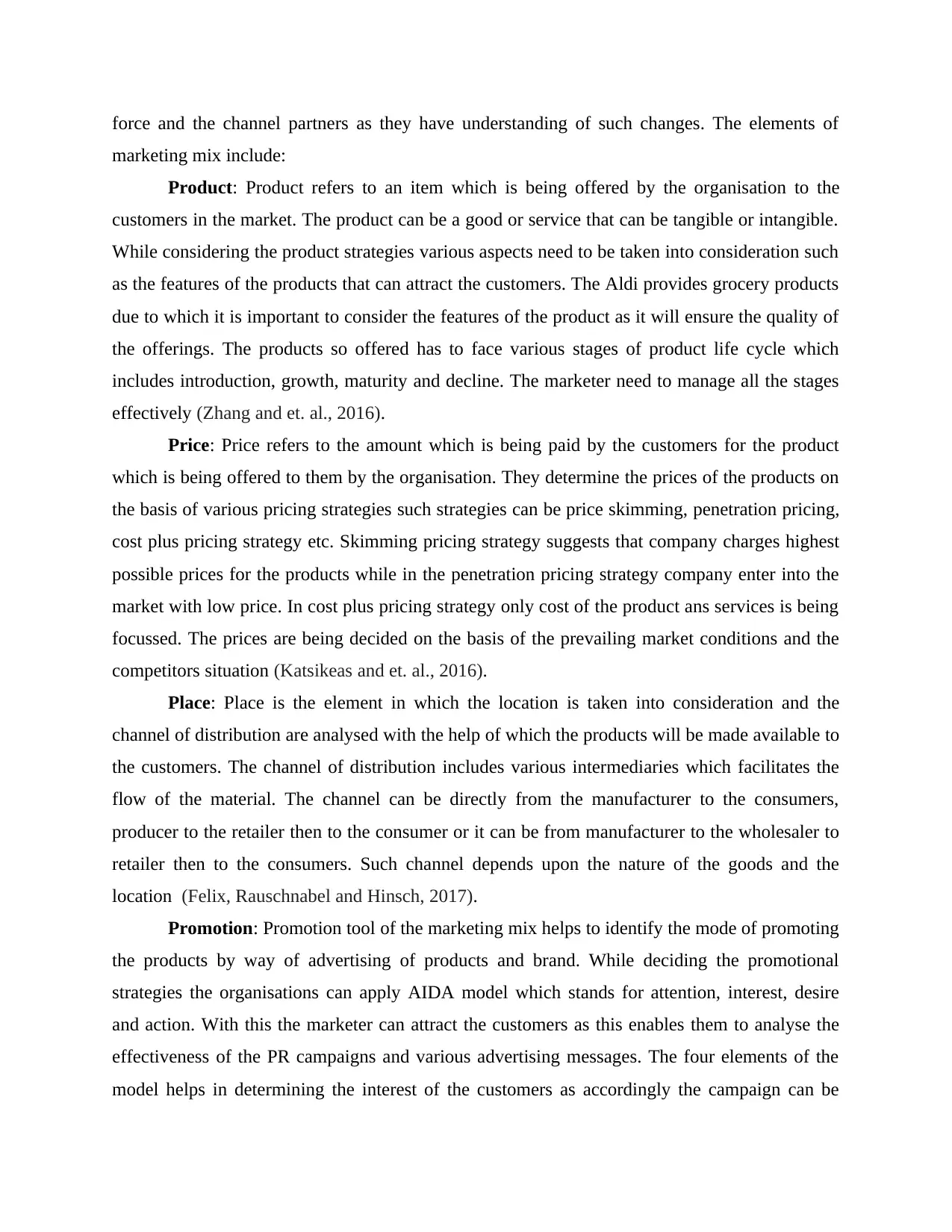
force and the channel partners as they have understanding of such changes. The elements of
marketing mix include:
Product: Product refers to an item which is being offered by the organisation to the
customers in the market. The product can be a good or service that can be tangible or intangible.
While considering the product strategies various aspects need to be taken into consideration such
as the features of the products that can attract the customers. The Aldi provides grocery products
due to which it is important to consider the features of the product as it will ensure the quality of
the offerings. The products so offered has to face various stages of product life cycle which
includes introduction, growth, maturity and decline. The marketer need to manage all the stages
effectively (Zhang and et. al., 2016).
Price: Price refers to the amount which is being paid by the customers for the product
which is being offered to them by the organisation. They determine the prices of the products on
the basis of various pricing strategies such strategies can be price skimming, penetration pricing,
cost plus pricing strategy etc. Skimming pricing strategy suggests that company charges highest
possible prices for the products while in the penetration pricing strategy company enter into the
market with low price. In cost plus pricing strategy only cost of the product ans services is being
focussed. The prices are being decided on the basis of the prevailing market conditions and the
competitors situation (Katsikeas and et. al., 2016).
Place: Place is the element in which the location is taken into consideration and the
channel of distribution are analysed with the help of which the products will be made available to
the customers. The channel of distribution includes various intermediaries which facilitates the
flow of the material. The channel can be directly from the manufacturer to the consumers,
producer to the retailer then to the consumer or it can be from manufacturer to the wholesaler to
retailer then to the consumers. Such channel depends upon the nature of the goods and the
location (Felix, Rauschnabel and Hinsch, 2017).
Promotion: Promotion tool of the marketing mix helps to identify the mode of promoting
the products by way of advertising of products and brand. While deciding the promotional
strategies the organisations can apply AIDA model which stands for attention, interest, desire
and action. With this the marketer can attract the customers as this enables them to analyse the
effectiveness of the PR campaigns and various advertising messages. The four elements of the
model helps in determining the interest of the customers as accordingly the campaign can be
marketing mix include:
Product: Product refers to an item which is being offered by the organisation to the
customers in the market. The product can be a good or service that can be tangible or intangible.
While considering the product strategies various aspects need to be taken into consideration such
as the features of the products that can attract the customers. The Aldi provides grocery products
due to which it is important to consider the features of the product as it will ensure the quality of
the offerings. The products so offered has to face various stages of product life cycle which
includes introduction, growth, maturity and decline. The marketer need to manage all the stages
effectively (Zhang and et. al., 2016).
Price: Price refers to the amount which is being paid by the customers for the product
which is being offered to them by the organisation. They determine the prices of the products on
the basis of various pricing strategies such strategies can be price skimming, penetration pricing,
cost plus pricing strategy etc. Skimming pricing strategy suggests that company charges highest
possible prices for the products while in the penetration pricing strategy company enter into the
market with low price. In cost plus pricing strategy only cost of the product ans services is being
focussed. The prices are being decided on the basis of the prevailing market conditions and the
competitors situation (Katsikeas and et. al., 2016).
Place: Place is the element in which the location is taken into consideration and the
channel of distribution are analysed with the help of which the products will be made available to
the customers. The channel of distribution includes various intermediaries which facilitates the
flow of the material. The channel can be directly from the manufacturer to the consumers,
producer to the retailer then to the consumer or it can be from manufacturer to the wholesaler to
retailer then to the consumers. Such channel depends upon the nature of the goods and the
location (Felix, Rauschnabel and Hinsch, 2017).
Promotion: Promotion tool of the marketing mix helps to identify the mode of promoting
the products by way of advertising of products and brand. While deciding the promotional
strategies the organisations can apply AIDA model which stands for attention, interest, desire
and action. With this the marketer can attract the customers as this enables them to analyse the
effectiveness of the PR campaigns and various advertising messages. The four elements of the
model helps in determining the interest of the customers as accordingly the campaign can be
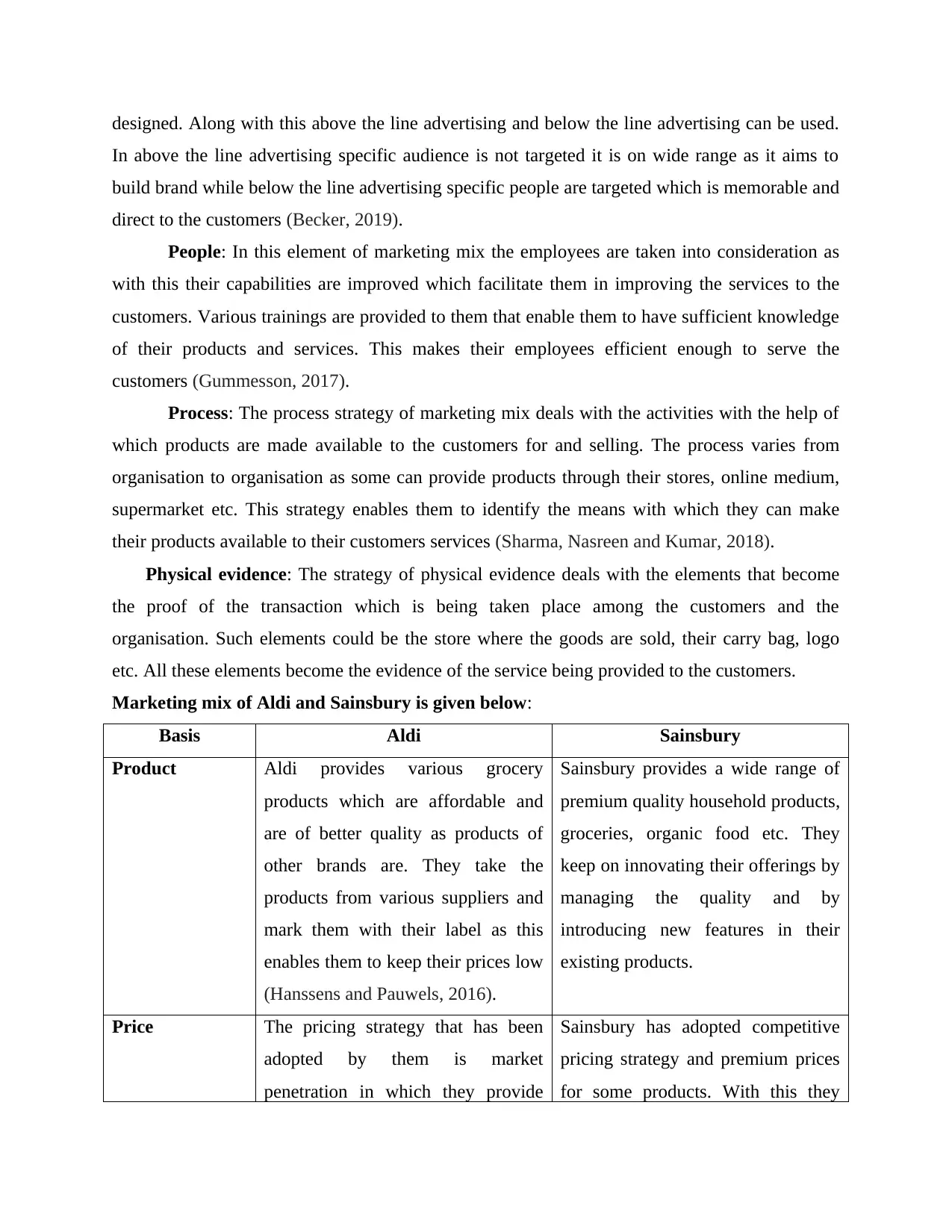
designed. Along with this above the line advertising and below the line advertising can be used.
In above the line advertising specific audience is not targeted it is on wide range as it aims to
build brand while below the line advertising specific people are targeted which is memorable and
direct to the customers (Becker, 2019).
People: In this element of marketing mix the employees are taken into consideration as
with this their capabilities are improved which facilitate them in improving the services to the
customers. Various trainings are provided to them that enable them to have sufficient knowledge
of their products and services. This makes their employees efficient enough to serve the
customers (Gummesson, 2017).
Process: The process strategy of marketing mix deals with the activities with the help of
which products are made available to the customers for and selling. The process varies from
organisation to organisation as some can provide products through their stores, online medium,
supermarket etc. This strategy enables them to identify the means with which they can make
their products available to their customers services (Sharma, Nasreen and Kumar, 2018).
Physical evidence: The strategy of physical evidence deals with the elements that become
the proof of the transaction which is being taken place among the customers and the
organisation. Such elements could be the store where the goods are sold, their carry bag, logo
etc. All these elements become the evidence of the service being provided to the customers.
Marketing mix of Aldi and Sainsbury is given below:
Basis Aldi Sainsbury
Product Aldi provides various grocery
products which are affordable and
are of better quality as products of
other brands are. They take the
products from various suppliers and
mark them with their label as this
enables them to keep their prices low
(Hanssens and Pauwels, 2016).
Sainsbury provides a wide range of
premium quality household products,
groceries, organic food etc. They
keep on innovating their offerings by
managing the quality and by
introducing new features in their
existing products.
Price The pricing strategy that has been
adopted by them is market
penetration in which they provide
Sainsbury has adopted competitive
pricing strategy and premium prices
for some products. With this they
In above the line advertising specific audience is not targeted it is on wide range as it aims to
build brand while below the line advertising specific people are targeted which is memorable and
direct to the customers (Becker, 2019).
People: In this element of marketing mix the employees are taken into consideration as
with this their capabilities are improved which facilitate them in improving the services to the
customers. Various trainings are provided to them that enable them to have sufficient knowledge
of their products and services. This makes their employees efficient enough to serve the
customers (Gummesson, 2017).
Process: The process strategy of marketing mix deals with the activities with the help of
which products are made available to the customers for and selling. The process varies from
organisation to organisation as some can provide products through their stores, online medium,
supermarket etc. This strategy enables them to identify the means with which they can make
their products available to their customers services (Sharma, Nasreen and Kumar, 2018).
Physical evidence: The strategy of physical evidence deals with the elements that become
the proof of the transaction which is being taken place among the customers and the
organisation. Such elements could be the store where the goods are sold, their carry bag, logo
etc. All these elements become the evidence of the service being provided to the customers.
Marketing mix of Aldi and Sainsbury is given below:
Basis Aldi Sainsbury
Product Aldi provides various grocery
products which are affordable and
are of better quality as products of
other brands are. They take the
products from various suppliers and
mark them with their label as this
enables them to keep their prices low
(Hanssens and Pauwels, 2016).
Sainsbury provides a wide range of
premium quality household products,
groceries, organic food etc. They
keep on innovating their offerings by
managing the quality and by
introducing new features in their
existing products.
Price The pricing strategy that has been
adopted by them is market
penetration in which they provide
Sainsbury has adopted competitive
pricing strategy and premium prices
for some products. With this they
⊘ This is a preview!⊘
Do you want full access?
Subscribe today to unlock all pages.

Trusted by 1+ million students worldwide
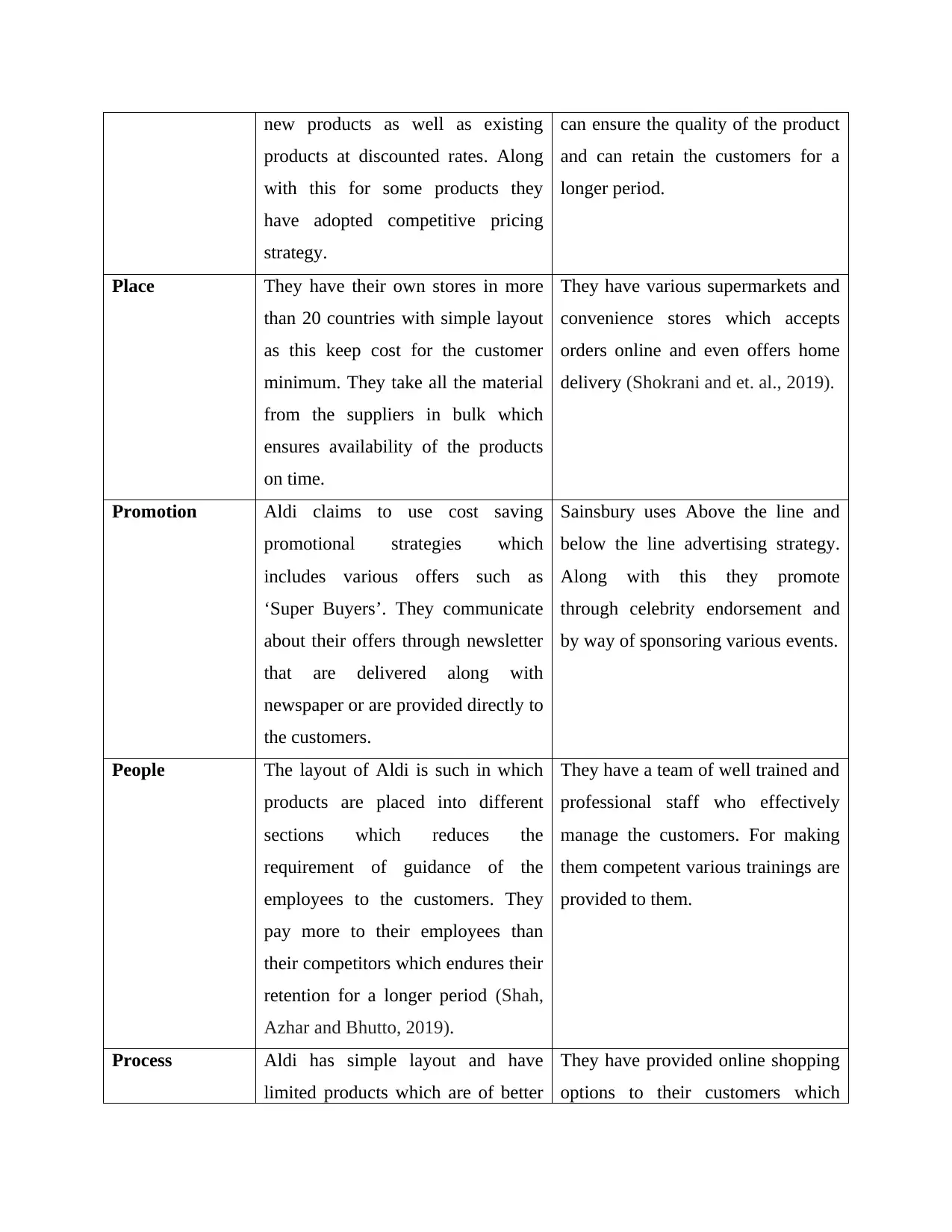
new products as well as existing
products at discounted rates. Along
with this for some products they
have adopted competitive pricing
strategy.
can ensure the quality of the product
and can retain the customers for a
longer period.
Place They have their own stores in more
than 20 countries with simple layout
as this keep cost for the customer
minimum. They take all the material
from the suppliers in bulk which
ensures availability of the products
on time.
They have various supermarkets and
convenience stores which accepts
orders online and even offers home
delivery (Shokrani and et. al., 2019).
Promotion Aldi claims to use cost saving
promotional strategies which
includes various offers such as
‘Super Buyers’. They communicate
about their offers through newsletter
that are delivered along with
newspaper or are provided directly to
the customers.
Sainsbury uses Above the line and
below the line advertising strategy.
Along with this they promote
through celebrity endorsement and
by way of sponsoring various events.
People The layout of Aldi is such in which
products are placed into different
sections which reduces the
requirement of guidance of the
employees to the customers. They
pay more to their employees than
their competitors which endures their
retention for a longer period (Shah,
Azhar and Bhutto, 2019).
They have a team of well trained and
professional staff who effectively
manage the customers. For making
them competent various trainings are
provided to them.
Process Aldi has simple layout and have
limited products which are of better
They have provided online shopping
options to their customers which
products at discounted rates. Along
with this for some products they
have adopted competitive pricing
strategy.
can ensure the quality of the product
and can retain the customers for a
longer period.
Place They have their own stores in more
than 20 countries with simple layout
as this keep cost for the customer
minimum. They take all the material
from the suppliers in bulk which
ensures availability of the products
on time.
They have various supermarkets and
convenience stores which accepts
orders online and even offers home
delivery (Shokrani and et. al., 2019).
Promotion Aldi claims to use cost saving
promotional strategies which
includes various offers such as
‘Super Buyers’. They communicate
about their offers through newsletter
that are delivered along with
newspaper or are provided directly to
the customers.
Sainsbury uses Above the line and
below the line advertising strategy.
Along with this they promote
through celebrity endorsement and
by way of sponsoring various events.
People The layout of Aldi is such in which
products are placed into different
sections which reduces the
requirement of guidance of the
employees to the customers. They
pay more to their employees than
their competitors which endures their
retention for a longer period (Shah,
Azhar and Bhutto, 2019).
They have a team of well trained and
professional staff who effectively
manage the customers. For making
them competent various trainings are
provided to them.
Process Aldi has simple layout and have
limited products which are of better
They have provided online shopping
options to their customers which
Paraphrase This Document
Need a fresh take? Get an instant paraphrase of this document with our AI Paraphraser
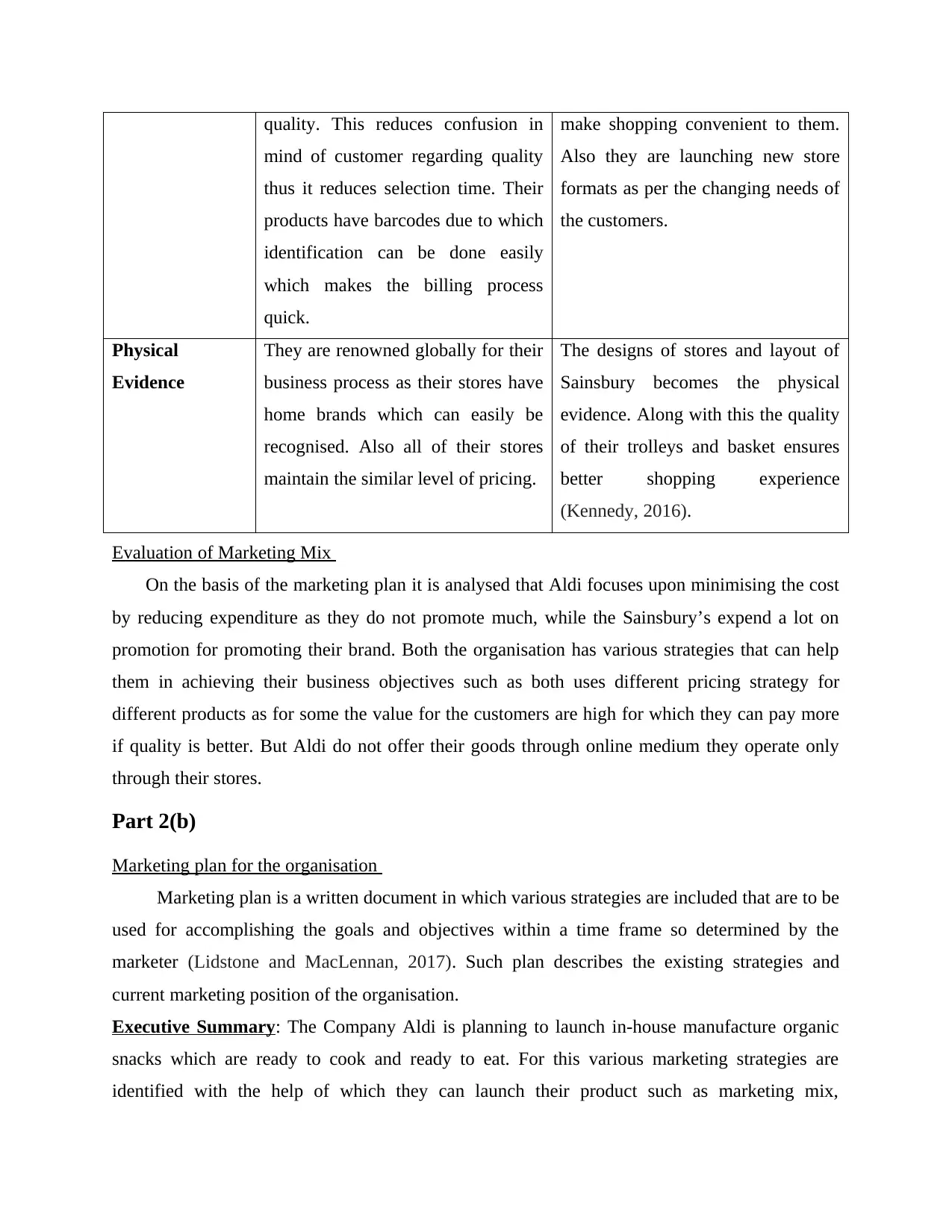
quality. This reduces confusion in
mind of customer regarding quality
thus it reduces selection time. Their
products have barcodes due to which
identification can be done easily
which makes the billing process
quick.
make shopping convenient to them.
Also they are launching new store
formats as per the changing needs of
the customers.
Physical
Evidence
They are renowned globally for their
business process as their stores have
home brands which can easily be
recognised. Also all of their stores
maintain the similar level of pricing.
The designs of stores and layout of
Sainsbury becomes the physical
evidence. Along with this the quality
of their trolleys and basket ensures
better shopping experience
(Kennedy, 2016).
Evaluation of Marketing Mix
On the basis of the marketing plan it is analysed that Aldi focuses upon minimising the cost
by reducing expenditure as they do not promote much, while the Sainsbury’s expend a lot on
promotion for promoting their brand. Both the organisation has various strategies that can help
them in achieving their business objectives such as both uses different pricing strategy for
different products as for some the value for the customers are high for which they can pay more
if quality is better. But Aldi do not offer their goods through online medium they operate only
through their stores.
Part 2(b)
Marketing plan for the organisation
Marketing plan is a written document in which various strategies are included that are to be
used for accomplishing the goals and objectives within a time frame so determined by the
marketer (Lidstone and MacLennan, 2017). Such plan describes the existing strategies and
current marketing position of the organisation.
Executive Summary: The Company Aldi is planning to launch in-house manufacture organic
snacks which are ready to cook and ready to eat. For this various marketing strategies are
identified with the help of which they can launch their product such as marketing mix,
mind of customer regarding quality
thus it reduces selection time. Their
products have barcodes due to which
identification can be done easily
which makes the billing process
quick.
make shopping convenient to them.
Also they are launching new store
formats as per the changing needs of
the customers.
Physical
Evidence
They are renowned globally for their
business process as their stores have
home brands which can easily be
recognised. Also all of their stores
maintain the similar level of pricing.
The designs of stores and layout of
Sainsbury becomes the physical
evidence. Along with this the quality
of their trolleys and basket ensures
better shopping experience
(Kennedy, 2016).
Evaluation of Marketing Mix
On the basis of the marketing plan it is analysed that Aldi focuses upon minimising the cost
by reducing expenditure as they do not promote much, while the Sainsbury’s expend a lot on
promotion for promoting their brand. Both the organisation has various strategies that can help
them in achieving their business objectives such as both uses different pricing strategy for
different products as for some the value for the customers are high for which they can pay more
if quality is better. But Aldi do not offer their goods through online medium they operate only
through their stores.
Part 2(b)
Marketing plan for the organisation
Marketing plan is a written document in which various strategies are included that are to be
used for accomplishing the goals and objectives within a time frame so determined by the
marketer (Lidstone and MacLennan, 2017). Such plan describes the existing strategies and
current marketing position of the organisation.
Executive Summary: The Company Aldi is planning to launch in-house manufacture organic
snacks which are ready to cook and ready to eat. For this various marketing strategies are
identified with the help of which they can launch their product such as marketing mix,
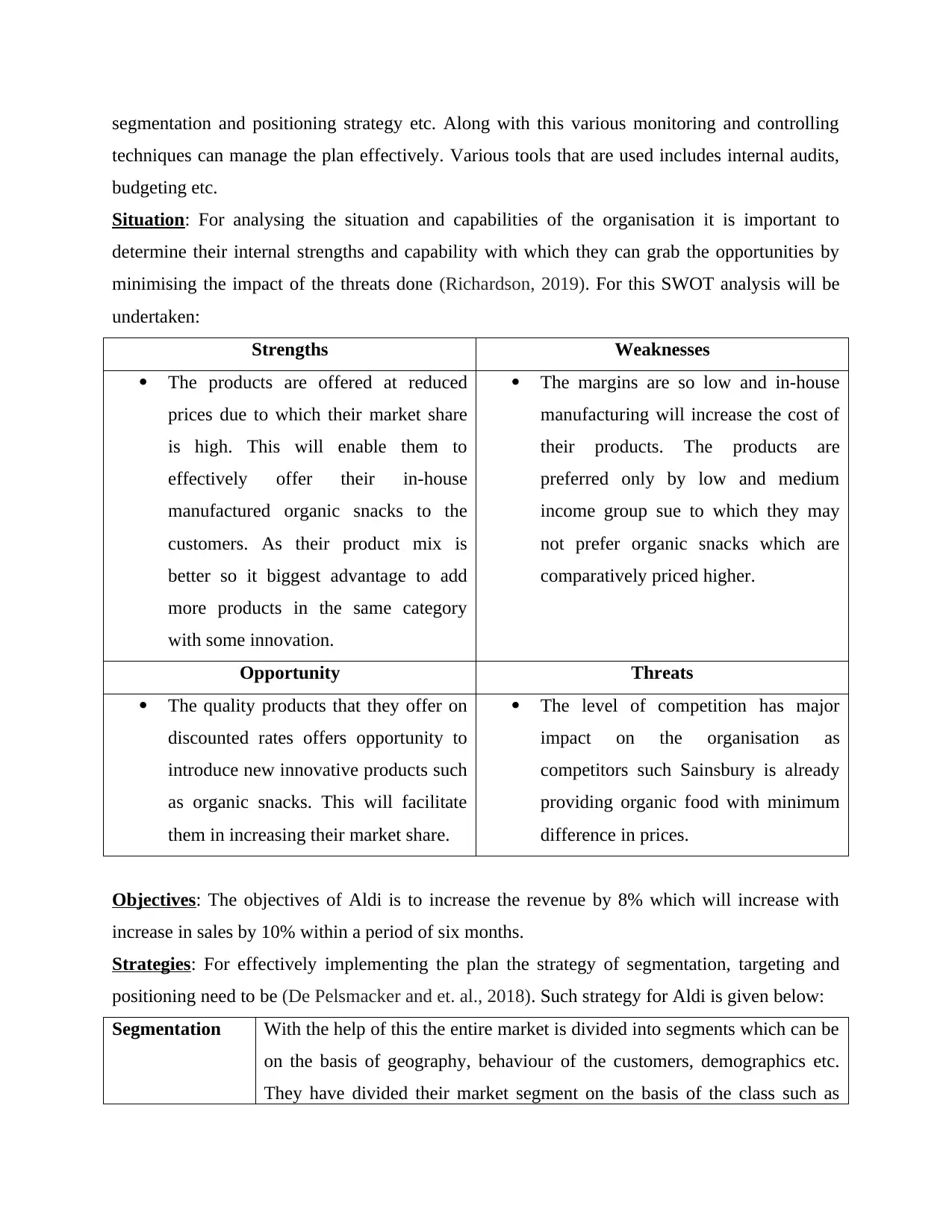
segmentation and positioning strategy etc. Along with this various monitoring and controlling
techniques can manage the plan effectively. Various tools that are used includes internal audits,
budgeting etc.
Situation: For analysing the situation and capabilities of the organisation it is important to
determine their internal strengths and capability with which they can grab the opportunities by
minimising the impact of the threats done (Richardson, 2019). For this SWOT analysis will be
undertaken:
Strengths Weaknesses
The products are offered at reduced
prices due to which their market share
is high. This will enable them to
effectively offer their in-house
manufactured organic snacks to the
customers. As their product mix is
better so it biggest advantage to add
more products in the same category
with some innovation.
The margins are so low and in-house
manufacturing will increase the cost of
their products. The products are
preferred only by low and medium
income group sue to which they may
not prefer organic snacks which are
comparatively priced higher.
Opportunity Threats
The quality products that they offer on
discounted rates offers opportunity to
introduce new innovative products such
as organic snacks. This will facilitate
them in increasing their market share.
The level of competition has major
impact on the organisation as
competitors such Sainsbury is already
providing organic food with minimum
difference in prices.
Objectives: The objectives of Aldi is to increase the revenue by 8% which will increase with
increase in sales by 10% within a period of six months.
Strategies: For effectively implementing the plan the strategy of segmentation, targeting and
positioning need to be (De Pelsmacker and et. al., 2018). Such strategy for Aldi is given below:
Segmentation With the help of this the entire market is divided into segments which can be
on the basis of geography, behaviour of the customers, demographics etc.
They have divided their market segment on the basis of the class such as
techniques can manage the plan effectively. Various tools that are used includes internal audits,
budgeting etc.
Situation: For analysing the situation and capabilities of the organisation it is important to
determine their internal strengths and capability with which they can grab the opportunities by
minimising the impact of the threats done (Richardson, 2019). For this SWOT analysis will be
undertaken:
Strengths Weaknesses
The products are offered at reduced
prices due to which their market share
is high. This will enable them to
effectively offer their in-house
manufactured organic snacks to the
customers. As their product mix is
better so it biggest advantage to add
more products in the same category
with some innovation.
The margins are so low and in-house
manufacturing will increase the cost of
their products. The products are
preferred only by low and medium
income group sue to which they may
not prefer organic snacks which are
comparatively priced higher.
Opportunity Threats
The quality products that they offer on
discounted rates offers opportunity to
introduce new innovative products such
as organic snacks. This will facilitate
them in increasing their market share.
The level of competition has major
impact on the organisation as
competitors such Sainsbury is already
providing organic food with minimum
difference in prices.
Objectives: The objectives of Aldi is to increase the revenue by 8% which will increase with
increase in sales by 10% within a period of six months.
Strategies: For effectively implementing the plan the strategy of segmentation, targeting and
positioning need to be (De Pelsmacker and et. al., 2018). Such strategy for Aldi is given below:
Segmentation With the help of this the entire market is divided into segments which can be
on the basis of geography, behaviour of the customers, demographics etc.
They have divided their market segment on the basis of the class such as
⊘ This is a preview!⊘
Do you want full access?
Subscribe today to unlock all pages.

Trusted by 1+ million students worldwide
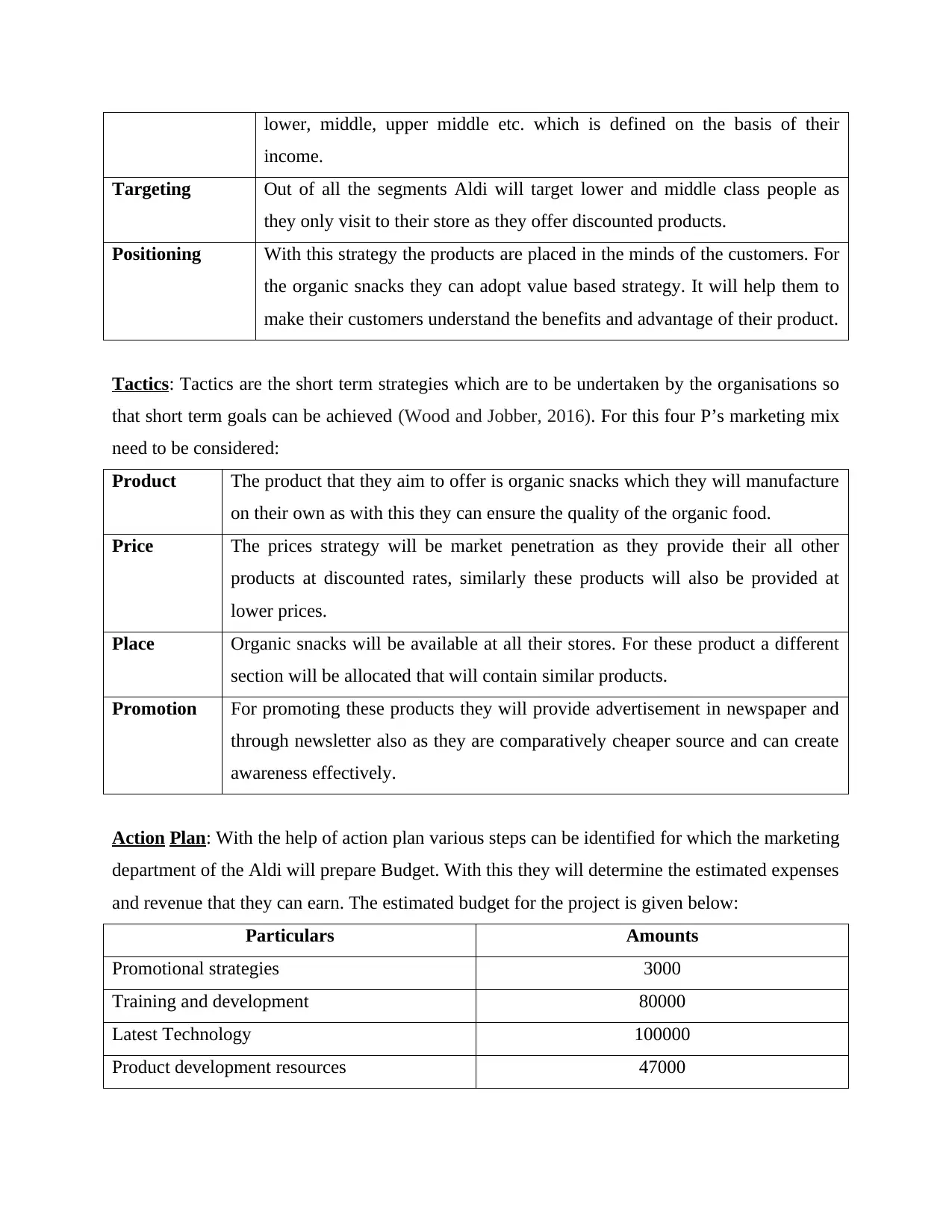
lower, middle, upper middle etc. which is defined on the basis of their
income.
Targeting Out of all the segments Aldi will target lower and middle class people as
they only visit to their store as they offer discounted products.
Positioning With this strategy the products are placed in the minds of the customers. For
the organic snacks they can adopt value based strategy. It will help them to
make their customers understand the benefits and advantage of their product.
Tactics: Tactics are the short term strategies which are to be undertaken by the organisations so
that short term goals can be achieved (Wood and Jobber, 2016). For this four P’s marketing mix
need to be considered:
Product The product that they aim to offer is organic snacks which they will manufacture
on their own as with this they can ensure the quality of the organic food.
Price The prices strategy will be market penetration as they provide their all other
products at discounted rates, similarly these products will also be provided at
lower prices.
Place Organic snacks will be available at all their stores. For these product a different
section will be allocated that will contain similar products.
Promotion For promoting these products they will provide advertisement in newspaper and
through newsletter also as they are comparatively cheaper source and can create
awareness effectively.
Action Plan: With the help of action plan various steps can be identified for which the marketing
department of the Aldi will prepare Budget. With this they will determine the estimated expenses
and revenue that they can earn. The estimated budget for the project is given below:
Particulars Amounts
Promotional strategies 3000
Training and development 80000
Latest Technology 100000
Product development resources 47000
income.
Targeting Out of all the segments Aldi will target lower and middle class people as
they only visit to their store as they offer discounted products.
Positioning With this strategy the products are placed in the minds of the customers. For
the organic snacks they can adopt value based strategy. It will help them to
make their customers understand the benefits and advantage of their product.
Tactics: Tactics are the short term strategies which are to be undertaken by the organisations so
that short term goals can be achieved (Wood and Jobber, 2016). For this four P’s marketing mix
need to be considered:
Product The product that they aim to offer is organic snacks which they will manufacture
on their own as with this they can ensure the quality of the organic food.
Price The prices strategy will be market penetration as they provide their all other
products at discounted rates, similarly these products will also be provided at
lower prices.
Place Organic snacks will be available at all their stores. For these product a different
section will be allocated that will contain similar products.
Promotion For promoting these products they will provide advertisement in newspaper and
through newsletter also as they are comparatively cheaper source and can create
awareness effectively.
Action Plan: With the help of action plan various steps can be identified for which the marketing
department of the Aldi will prepare Budget. With this they will determine the estimated expenses
and revenue that they can earn. The estimated budget for the project is given below:
Particulars Amounts
Promotional strategies 3000
Training and development 80000
Latest Technology 100000
Product development resources 47000
Paraphrase This Document
Need a fresh take? Get an instant paraphrase of this document with our AI Paraphraser
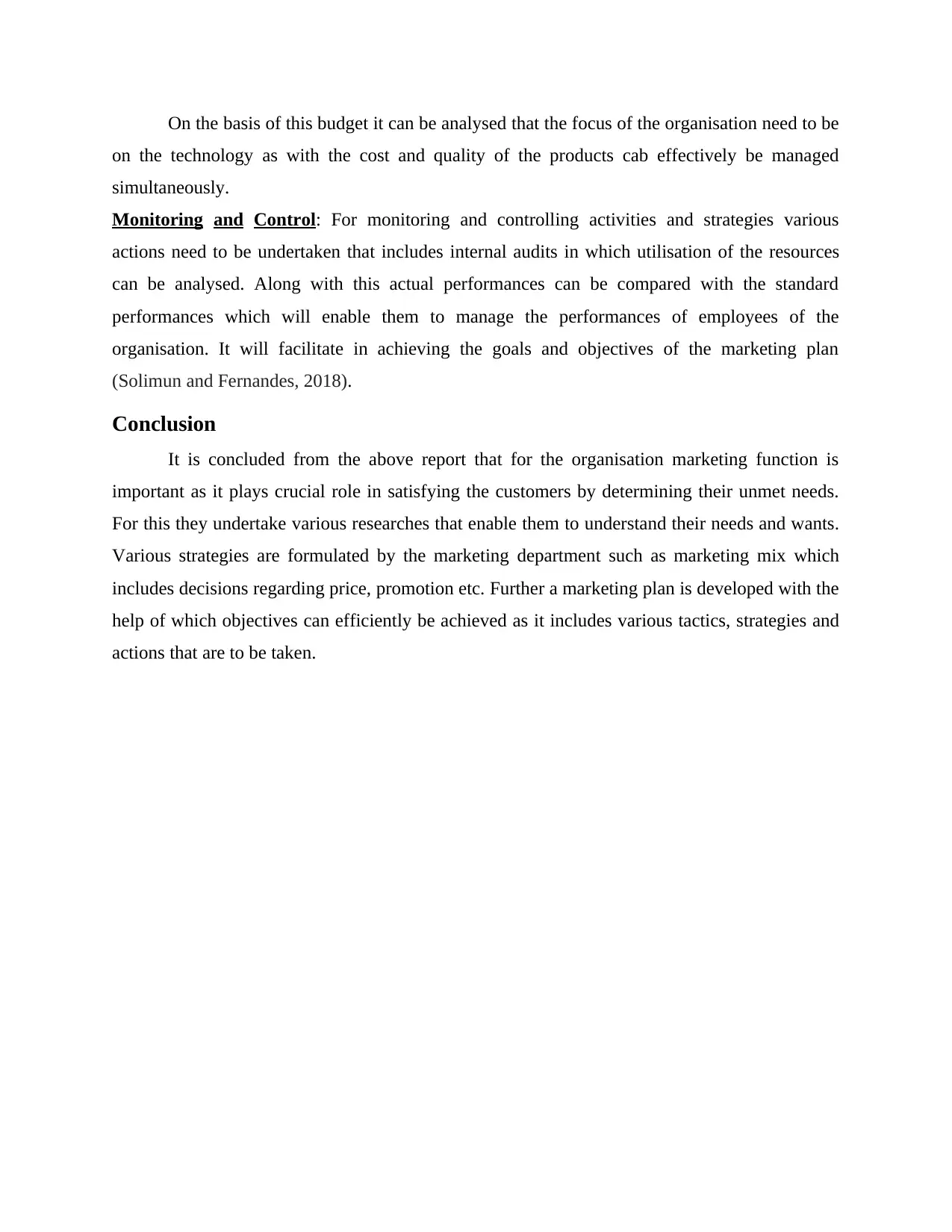
On the basis of this budget it can be analysed that the focus of the organisation need to be
on the technology as with the cost and quality of the products cab effectively be managed
simultaneously.
Monitoring and Control: For monitoring and controlling activities and strategies various
actions need to be undertaken that includes internal audits in which utilisation of the resources
can be analysed. Along with this actual performances can be compared with the standard
performances which will enable them to manage the performances of employees of the
organisation. It will facilitate in achieving the goals and objectives of the marketing plan
(Solimun and Fernandes, 2018).
Conclusion
It is concluded from the above report that for the organisation marketing function is
important as it plays crucial role in satisfying the customers by determining their unmet needs.
For this they undertake various researches that enable them to understand their needs and wants.
Various strategies are formulated by the marketing department such as marketing mix which
includes decisions regarding price, promotion etc. Further a marketing plan is developed with the
help of which objectives can efficiently be achieved as it includes various tactics, strategies and
actions that are to be taken.
on the technology as with the cost and quality of the products cab effectively be managed
simultaneously.
Monitoring and Control: For monitoring and controlling activities and strategies various
actions need to be undertaken that includes internal audits in which utilisation of the resources
can be analysed. Along with this actual performances can be compared with the standard
performances which will enable them to manage the performances of employees of the
organisation. It will facilitate in achieving the goals and objectives of the marketing plan
(Solimun and Fernandes, 2018).
Conclusion
It is concluded from the above report that for the organisation marketing function is
important as it plays crucial role in satisfying the customers by determining their unmet needs.
For this they undertake various researches that enable them to understand their needs and wants.
Various strategies are formulated by the marketing department such as marketing mix which
includes decisions regarding price, promotion etc. Further a marketing plan is developed with the
help of which objectives can efficiently be achieved as it includes various tactics, strategies and
actions that are to be taken.
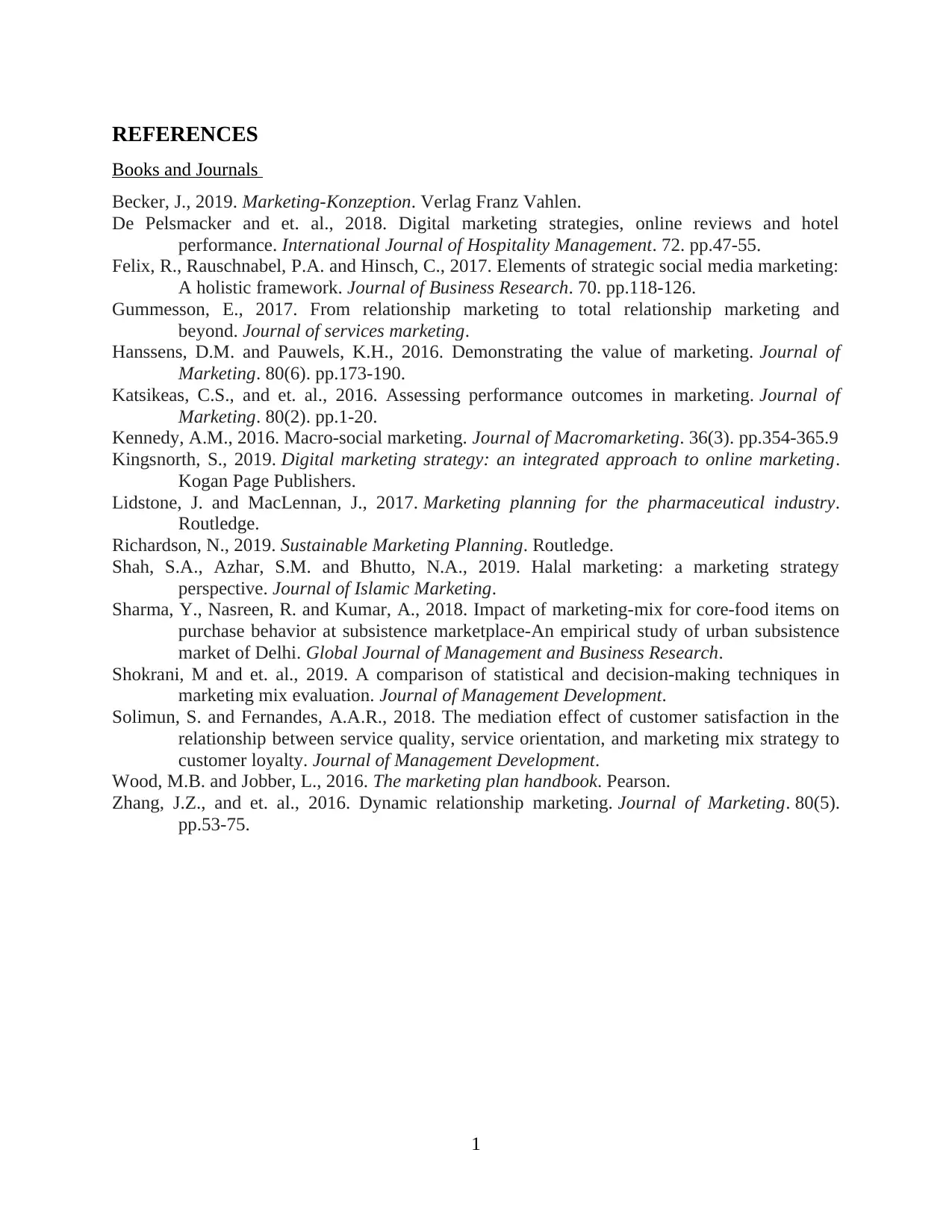
REFERENCES
Books and Journals
Becker, J., 2019. Marketing-Konzeption. Verlag Franz Vahlen.
De Pelsmacker and et. al., 2018. Digital marketing strategies, online reviews and hotel
performance. International Journal of Hospitality Management. 72. pp.47-55.
Felix, R., Rauschnabel, P.A. and Hinsch, C., 2017. Elements of strategic social media marketing:
A holistic framework. Journal of Business Research. 70. pp.118-126.
Gummesson, E., 2017. From relationship marketing to total relationship marketing and
beyond. Journal of services marketing.
Hanssens, D.M. and Pauwels, K.H., 2016. Demonstrating the value of marketing. Journal of
Marketing. 80(6). pp.173-190.
Katsikeas, C.S., and et. al., 2016. Assessing performance outcomes in marketing. Journal of
Marketing. 80(2). pp.1-20.
Kennedy, A.M., 2016. Macro-social marketing. Journal of Macromarketing. 36(3). pp.354-365.9
Kingsnorth, S., 2019. Digital marketing strategy: an integrated approach to online marketing.
Kogan Page Publishers.
Lidstone, J. and MacLennan, J., 2017. Marketing planning for the pharmaceutical industry.
Routledge.
Richardson, N., 2019. Sustainable Marketing Planning. Routledge.
Shah, S.A., Azhar, S.M. and Bhutto, N.A., 2019. Halal marketing: a marketing strategy
perspective. Journal of Islamic Marketing.
Sharma, Y., Nasreen, R. and Kumar, A., 2018. Impact of marketing-mix for core-food items on
purchase behavior at subsistence marketplace-An empirical study of urban subsistence
market of Delhi. Global Journal of Management and Business Research.
Shokrani, M and et. al., 2019. A comparison of statistical and decision-making techniques in
marketing mix evaluation. Journal of Management Development.
Solimun, S. and Fernandes, A.A.R., 2018. The mediation effect of customer satisfaction in the
relationship between service quality, service orientation, and marketing mix strategy to
customer loyalty. Journal of Management Development.
Wood, M.B. and Jobber, L., 2016. The marketing plan handbook. Pearson.
Zhang, J.Z., and et. al., 2016. Dynamic relationship marketing. Journal of Marketing. 80(5).
pp.53-75.
1
Books and Journals
Becker, J., 2019. Marketing-Konzeption. Verlag Franz Vahlen.
De Pelsmacker and et. al., 2018. Digital marketing strategies, online reviews and hotel
performance. International Journal of Hospitality Management. 72. pp.47-55.
Felix, R., Rauschnabel, P.A. and Hinsch, C., 2017. Elements of strategic social media marketing:
A holistic framework. Journal of Business Research. 70. pp.118-126.
Gummesson, E., 2017. From relationship marketing to total relationship marketing and
beyond. Journal of services marketing.
Hanssens, D.M. and Pauwels, K.H., 2016. Demonstrating the value of marketing. Journal of
Marketing. 80(6). pp.173-190.
Katsikeas, C.S., and et. al., 2016. Assessing performance outcomes in marketing. Journal of
Marketing. 80(2). pp.1-20.
Kennedy, A.M., 2016. Macro-social marketing. Journal of Macromarketing. 36(3). pp.354-365.9
Kingsnorth, S., 2019. Digital marketing strategy: an integrated approach to online marketing.
Kogan Page Publishers.
Lidstone, J. and MacLennan, J., 2017. Marketing planning for the pharmaceutical industry.
Routledge.
Richardson, N., 2019. Sustainable Marketing Planning. Routledge.
Shah, S.A., Azhar, S.M. and Bhutto, N.A., 2019. Halal marketing: a marketing strategy
perspective. Journal of Islamic Marketing.
Sharma, Y., Nasreen, R. and Kumar, A., 2018. Impact of marketing-mix for core-food items on
purchase behavior at subsistence marketplace-An empirical study of urban subsistence
market of Delhi. Global Journal of Management and Business Research.
Shokrani, M and et. al., 2019. A comparison of statistical and decision-making techniques in
marketing mix evaluation. Journal of Management Development.
Solimun, S. and Fernandes, A.A.R., 2018. The mediation effect of customer satisfaction in the
relationship between service quality, service orientation, and marketing mix strategy to
customer loyalty. Journal of Management Development.
Wood, M.B. and Jobber, L., 2016. The marketing plan handbook. Pearson.
Zhang, J.Z., and et. al., 2016. Dynamic relationship marketing. Journal of Marketing. 80(5).
pp.53-75.
1
⊘ This is a preview!⊘
Do you want full access?
Subscribe today to unlock all pages.

Trusted by 1+ million students worldwide
1 out of 12
Related Documents
Your All-in-One AI-Powered Toolkit for Academic Success.
+13062052269
info@desklib.com
Available 24*7 on WhatsApp / Email
![[object Object]](/_next/static/media/star-bottom.7253800d.svg)
Unlock your academic potential
Copyright © 2020–2025 A2Z Services. All Rights Reserved. Developed and managed by ZUCOL.





